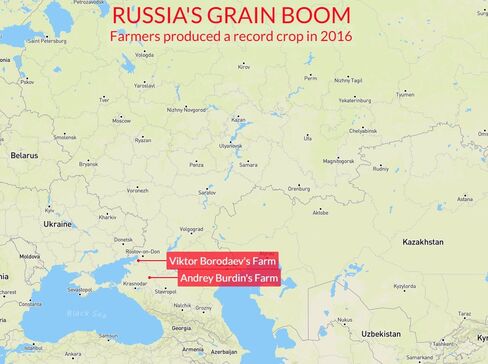Over the last few years, Burdin has tripled the size of his farm on the steppe near the Black Sea, winning prizes from the local government for how much wheat he’s produced from the rich soil here and pumping profits back into new tractors and sprayers.
His harvest this season will be a third bigger than what it was just five years ago, helping fuel an explosion in grain exports that has allowed Russia to displace longtime global leaders like the U.S. and European Union.
Long known for its oil and gas, Russia is now moving to retake leadership in the world wheat trade it last held when the Czars ruled. In the process, it’s reshaping the market for one of the world’s most important traded food products.
“People have started to think about the future,” said Burdin, 42 years old, new tractors lined up outside the window of his office. “Before, everyone just lived day to day.”
Farm Renaissance
He plans to buy a Deere & Co. sprayer for 20 million rubles ($311,000) to add to his fleet in time for planting next spring, he said.From the Black Sea coast and the Volga River heartland to the sun-scorched steppes of Siberia, Russia’s farm belt is enjoying a renaissance, with grain at the leading edge. Turbocharged by the 45 percent drop in the ruble against the dollar over the last few years and bumper crops, local producers are crowding into export markets long dominated by big western players.
Last season, Russian topped the U.S. in wheat exports for the first time in decades and is expected to extend those gains to displace the EU from the top spot this year, according to the U.S. Department of Agriculture. Investors from local farmers to billionaire tycoons are pumping money into the business.

“Russia will be among the top exporters for a long time, especially given the potential advances in productivity there,” said Tom Basnett, general manager at Market Check, a Sydney-based commodity consultant. “Other producers need to fight harder to maintain their traditional markets.”
The boom in Russia is attracting some of the world’s biggest trading houses, with Olam International Ltd., Cargill Inc. and Glencore Plc investing into everything from silos to export terminals.
Rich soil, government support and proximity to Black Sea ports for shipping means Russian costs can be as little as half those of major competitors supplying key import markets in the Middle East, according to researchers at Kansas State University.
Rivals Shift
Many growers in the U.S. and Europe have turned to higher-quality wheat to compete with the Russian supplies, which are mostly softer varieties that fetch lower prices. Some have also cut wheat plantings, which in the U.S. are expected to be the lowest next year since 1919, according to The Scoular Co., a Kansas grain supplier.Limited storage capacity means most of the Russian crop is sold shortly after it’s harvested, further depressing prices. Moscow has also imposed export tariffs and even a ban in the last several years in an effort to keep domestic prices down, scaring foreign buyers. The 2010 ban sent prices skyrocketing in key markets like Egypt, fueling unrest that contributed to a revolution.
But exports have been growing since Russia first returned in volume to the global wheat market in 2002. Over the first seven months of this year, farm and food exports were 5.5 percent of Russia’s total, still far behind top-ranked oil and gas but the highest share in at least 15 years and more than big earners like weapons, according to official data.
“With our nature and climate, it’s our destiny to be an exporter,” said Arkady Zlochevsky, president of the Russian Grain Union, an industry group.
The price of Russian wheat for export from Black Sea ports dropped to the lowest in at least six years in July and was last at $169 a metric ton as of Sept. 30, according to the Institute for Agricultural Market Studies. Wheat for December delivery added 0.4 percent in Chicago on Friday.

Burdin was granted five hectares of land for his own use in the early 1990s, when his collective farm collapsed in the wake of the demise of the Soviet Union. After working as a hired hand, he struck out on his own in 2005. He traded his old Lada for a used Russian tractor. He said he barely earned enough for food. “It was hard when we started out.”
Now he drives a late-model Ford pickup. His fleet includes a half-dozen imported tractors and four combines, along with a German machine to spread the fertilizer that’s helped him to victory in local wheat-yields contests. He owns 200 hectares (500 acres) of land and rents another 1,500.
Farm Riches
A few miles away, Viktor Borodaev, 64, said he and other farmers don’t deserve all the credit for the recent boom. “We got a lot of help from God and nature,” he said, referring to the favorable weather that’s yielded bumper crops in recent years.
Last week, Agriculture Minister Alexander Tkachev reported to President Vladimir Putin in the Kremlin, predicting the best harvest in 25 years and forecasting it could grow another 20 percent over the next decade or so.
“Exports give us a flow of cash, hard currency, from which our farm producers get rich,” said Tkachev, whose family is a major owner of farms and agricultural land in southern Russia.












